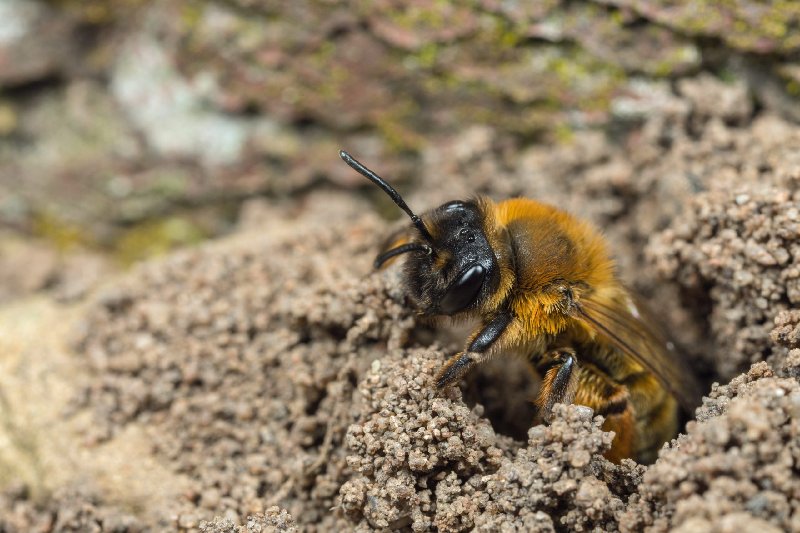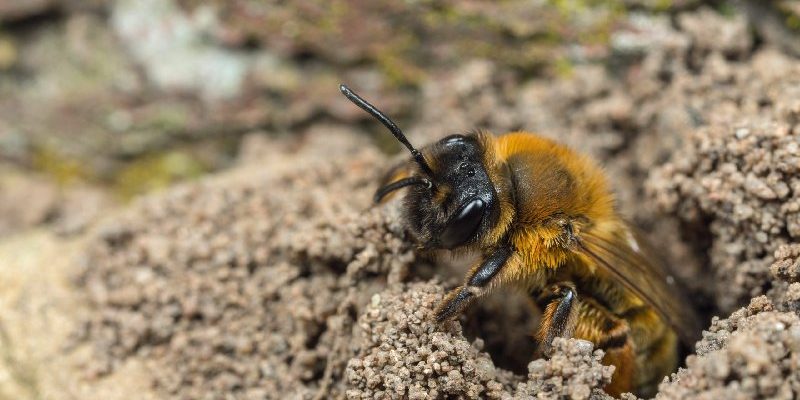
Mining bees belong to the family Andrenidae and are known for their unique nesting habits. Unlike honeybees, which live in hives, mining bees prefer to dig their own homes in the ground, which is where the magic happens. Let’s take a deeper dive into their habitats and how they create their nests, so you can appreciate these hardworking pollinators even more.
What Is a Mining Bee?
Mining bees are solitary bees, meaning they don’t live in colonies like some other bee species. They range in size from about 7 to 15 millimeters long and can come in a variety of colors, including black, brown, and even metallic shades. You’ll often find them darting around flowers when it’s warm, busily collecting pollen and nectar.
These bees are called “mining bees” because they dig tunnels in the ground to create their nests. They are well-optimized for this underground lifestyle, with bodies that are built for burrowing. You might be wondering what makes them so special—well, they are excellent pollinators and contribute to the health of various flowering plants by spreading pollen as they go.
Where Do Mining Bees Live?
Mining bees can be found in a variety of habitats, which is part of what makes them so adaptable. You can encounter them in gardens, meadows, and even open fields. They appreciate bare patches of soil that provide easy access for tunneling.
Here are some common locations where mining bees thrive:
- Urban Gardens: Many mining bees have adapted to city life, making gardens their home.
- Meadows: Natural habitats with a mix of wildflowers are a perfect setting for these bees.
- Open Fields: They love spaces that offer plenty of sunlight and the right kind of soil for digging.
Interestingly, they prefer sandy or loamy soil, which allows them to dig easier tunnels. Whereas clayey soil might pose a challenge for them, they thrive in the right conditions. So, if you’re keen on attracting mining bees to your garden, consider creating those bare patches of soil by reducing mulch or ground cover.
The Nesting Process: How Do They Create Their Homes?
Let’s get to the heart of what makes mining bees so unique: their nesting behavior. When a female mining bee is ready to lay eggs, she seeks out the perfect spot—that ideal bare patch of soil we mentioned earlier.
Here’s a step-by-step look at how they go about it:
1. Finding a Location: The female scans the area for an ideal site with loose soil and plenty of sunlight.
2. Digging the Tunnel: Once she’s picked her spot, she starts to dig. This can take a few hours, and the tunnels can extend several inches deep, sometimes even reaching up to a few feet.
3. Creating Cells: Inside the tunnel, she crafts separate cells where she will lay her eggs. Each cell is packed with pollen and nectar to feed the larva once they hatch.
4. Laying Eggs: After preparing the cells, she lays one egg in each and seals them up.
The meticulous process ensures that each larva has food right after they emerge, allowing them to thrive. Isn’t that thoughtful?
Seasonal Habits and Life Cycle
Mining bees have a pretty structured life cycle that is closely tied to the seasons. Most species emerge in the spring when temperatures rise and flowers start blooming. This timing is crucial for their survival.
Typically, the life cycle consists of four stages:
- Egg: Laid in the spring; each egg develops inside the sealed cell.
- Larva: Upon hatching, the larva consumes the stored pollen and nectar.
- Pupa: After eating enough, the larva pupates inside the cell.
- Adult Bee: Eventually, the mature bee emerges in spring ready to mate and lay eggs.
The entire process is about a year long, with adult mining bees only around for a short time to complete their reproductive cycle. This seasonal behavior ensures they make the most of the blooming flowers to gather food and reproduce.
The Importance of Mining Bees in Ecosystems
You might be surprised to learn just how important mining bees are for our ecosystems. While they might not get as much attention as honeybees, they play a critical role in pollination.
Their solitary nature allows them to pollinate a wide variety of plants, which is vital for biodiversity. They are particularly effective at pollinating certain wildflowers and crops. A healthy population of mining bees means healthier plants and, ultimately, a thriving ecosystem.
Additionally, because they nest underground, their activities help aerate the soil and promote healthy soil ecosystems. This can lead to improved plant growth, which benefits not just the bees but also other wildlife and even us as humans.
How to Attract Mining Bees to Your Garden
If you’re looking to support mining bees and encourage them to visit your garden, there are several things you can do. Here are a few simple tips:
1. Create Bare Patches: Set aside areas without mulch or grass. Bare soil is critical for nesting.
2. Plant Native Flowers: Choose wildflowers that bloom at different times throughout the season. This ensures a continuous food supply.
3. Avoid Pesticides: Chemicals can harm mining bees and other beneficial insects. Try organic methods for pest control.
4. Leave Some Soil Untouched: Instead of making everything tidy, leave some areas a bit wild. This encourages more bee activity.
By following these steps, you’re not just helping the mining bees; you’re also contributing to the health of your environment.
Common Misconceptions About Mining Bees
There are plenty of myths surrounding mining bees that might make people hesitant to welcome them into their gardens. Let’s clear up a few of these misunderstandings:
– “Mining bees sting!”: This is a common fear, but here’s the thing—mining bees are typically non-aggressive. They rarely sting unless provoked.
– “They are a nuisance!”: Unlike wasps, mining bees don’t invade homes or create large colonies. Their solitary lifestyle makes them quite peaceful companions in the garden.
– “They’re just like honeybees.”: While they do share some similarities, mining bees are unique and have distinct behaviors and habitat preferences.
Understanding these differences can help you appreciate the role of mining bees without fear.
As you can see, mining bees are much more than just another insect—these amazing little pollinators are vital to our ecosystem. Their fascinating nesting behaviors, seasonal rituals, and essential contributions make them truly special. So, the next time you see a mining bee buzzing around, take a moment to appreciate the hardworking role they play in keeping our world blooming and alive. Let’s do our part to support them!

